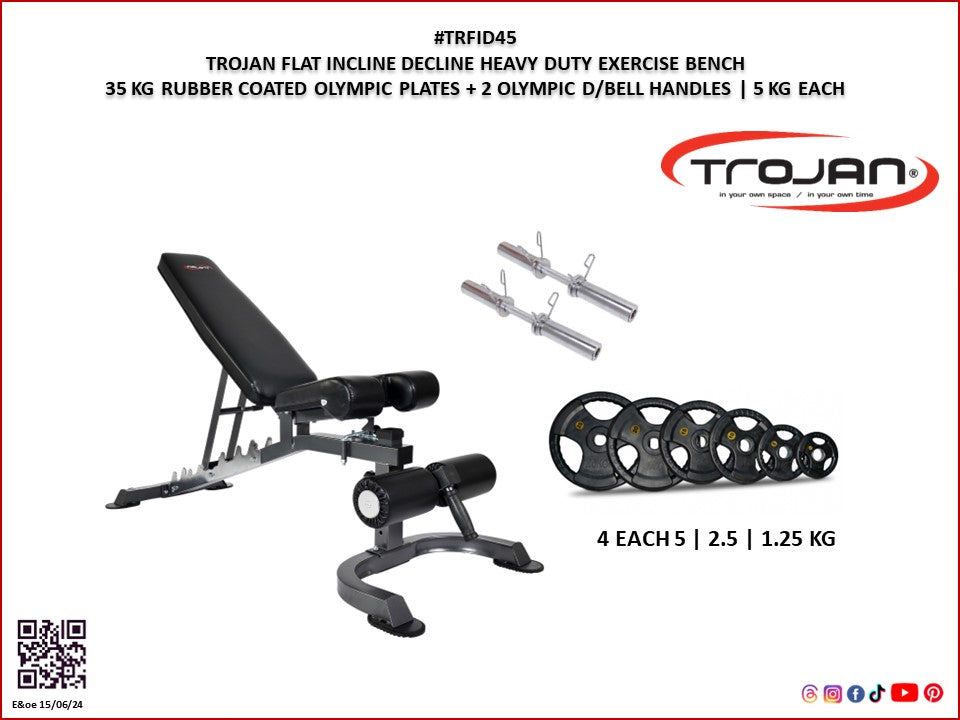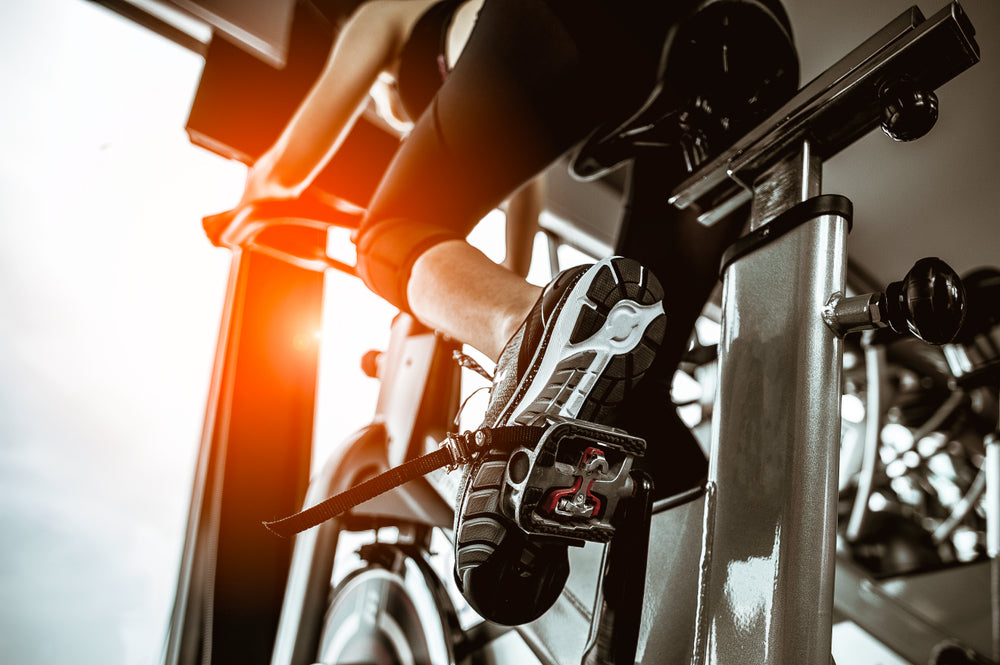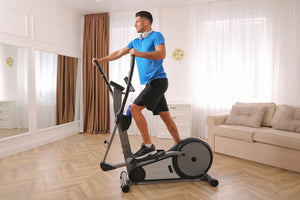How to Lose Weight with Indoor Cycling | Benefits of Stationary Bike

Losing weight in a hectic daily schedule can feel like looking for a needle in a haystack, as regular work, family, and social obligations frequently leaves no time for workout and healthy food preparation.
- Have you ever heard of indoor cycling?
- What are the benefits of indoor cycling?
- How indoor cycling helps you losing weight in a healthy way?
- Where to get best indoor cycling option?
- Are there any tips for losing weight with stationary bikes?
- Is there any specific exercise plan with stationary bike?
- What are the myths for indoor cycling?
Okkkkk… We got you covered.
Trojan Fitness understand your curiosity regarding this home gym fitness machine. So, in this article we have brought the comprehensive guide about stationary bike, its benefits and exercise plans. This will help you understanding your weight loss goal and how it can be helpful for all body types.
Stationary exercise bike referred to as a spin cycle, bike trainer, fitness bike, indoor bike, bike machine or gym bike, which can improve health of your heart, lungs, and muscles.
Lose Weight with Indoor Cycling | Benefits of Stationary Bike
Compared to certain other forms of cardiovascular equipment, a stationary bicycle places less strain on your joints, making it an excellent choice for an aerobic workout. Discover more about the advantages of a workout on a stationary bike and different exercise plans that can help you achieve your fitness and weight loss objectives.
This article will delve into how indoor cycling can assist in reaching your weight loss targets and attaining your ideal body weight. While maintaining a healthy weight heavily relies on nutrition, incorporating indoor cycling into your routine can be a potent tool for shedding those extra pounds.
What Are The Benefits Of A Stationary Bike Workout?
Cycle Your Way to Fit & Better Day
The advantages of incorporating a stationary bike workout into your fitness routine are manifold, and the positive impacts on your physical and mental health are substantial.
Enhanced Cardio Fitness:
Engaging in a stationary bike regimen brings about several heart and lung health improvements. It fosters better blood circulation, which, in turn, yields a range of health benefits. Additionally, it contributes to memory enhancement, improved brain function, and a boost in mood. Furthermore, it plays a role in reducing blood pressure and stress levels, thus promoting overall mental well-being. The enhanced circulation also translates to improved sleep quality, a bolstered immune system, and increased energy levels, all of which collectively support better blood sugar control.
Weight Management:
Stationary biking is a potent tool for weight management. Depending on your intensity and body weight, you can torch over 600 calories per hour. When combined with a well-balanced diet, it proves effective in achieving and sustaining weight loss goals.
Fat Burning:
High-intensity stationary bike workouts offer a dual benefit of calorie incineration and muscle strengthening, which contributes to fat loss. Pairing such workouts with a low-calorie diet can result in noticeable reductions in body weight, body fat, as well as cholesterol and triglyceride levels.
Low-Impact Exercise:
A stationary bike provides a low-impact workout, making it especially suitable for individuals with joint issues or injuries. It minimizes stress on joints, such as ankles, knees, and hips, in contrast to high-impact exercises, while still delivering an effective workout experience.
Leg and Lower Body Strengthening:
Consistent stationary bike workouts develop leg muscles, including the calves, hamstrings, and quadriceps. These workouts also engage the core, back, and glute muscles. In some cases, stationary bikes equipped with handles can target upper body muscles like the biceps, triceps, and shoulders, ensuring a comprehensive workout.
Interval Training:
Stationary bikes offer the flexibility to engage in interval training, allowing you to alternate between intense and less intense exercise. This not only amplifies calorie burn but also elevates your cardio fitness. The adjustable resistance levels on most stationary bikes facilitate this type of training.
Cardiovascular Health:
Indoor cycling is an excellent cardiovascular workout that helps strengthen the heart muscle and enhance its efficiency. Regular cycling can lower the risk of heart diseases, including coronary artery disease and high blood pressure.
Muscle Toning:
Cycling primarily targets the lower body muscles, including the quadriceps, hamstrings, calves, and glutes. Regular cycling can lead to improved muscle tone and endurance in these muscle groups.
Mental Wellbeing:
Stress Reduction- Exercise, including indoor cycling, triggers the release of endorphins, which are natural mood elevators. Cycling can help reduce stress, alleviate symptoms of anxiety and depression, and improve overall mental wellbeing.
Convenience:
Indoor cycling can be done at any time of the day, regardless of weather conditions or outdoor restrictions. Many people opt for indoor cycling at gyms or in the comfort of their own homes, providing convenience and flexibility.
Tracking Progress:
Data and Metrics- Most indoor cycling bikes are equipped with digital displays that provide real-time data on speed, distance, resistance, and calories burned. Tracking these metrics can help individuals set and achieve fitness goals.
Time Efficiency:
A 30- to 45-minute indoor cycling session can deliver an effective workout that burns calories, increases heart rate, and provides a sense of accomplishment in a relatively short amount of time.
Versatility:
Cross-Training- Indoor cycling can be integrated into a broader fitness regimen, serving as an excellent cross-training activity to complement other exercises like strength training, yoga, or swimming.
Workout Plans with Indoor Cycling For Different Fitness Levels:

The indoor cycling workout routines offer a versatile approach to accommodating various fitness levels and objectives.
Here are the few plans, individuals aiming for weight loss, and those pursuing interval training:
When commencing your indoor cycling journey, it is essential to approach your workouts gradually to prevent injuries and steadily improve your fitness. Here is an example of a beginner’s workout plan:
Duration: 25-35 minutes
Initiate with a 5-10 minute warm-up at a low-intensity pace. Transition to medium intensity for 5 minutes. Alternate between high-intensity periods lasting 1-2 minutes and medium-intensity intervals spanning 5 minutes. Conclude the workout with 5 minutes of low-intensity pedaling. As you make progress, consider adding 1-minute increments to your workout while gradually extending the overall duration.
Indoor cycling is a potent choice for shedding calories and supporting weight loss. Here is a sample weight loss workout regimen:
Duration: 30-40 minutes
Commence with a 5-10 minute warm-up at a low-intensity pace. Switch to medium intensity for 3-5 minutes. Cycle between high-intensity segments (1-3 minutes) and medium-intensity phases (3-5 minutes) for 20 to 30 minutes. Wrap up the session with a 5-10 minute low-intensity cool-down. Be sure to monitor your heart rate and adjust your intensity to maintain an effective calorie-burning zone.
Interval training is an excellent approach for enhancing your strength and endurance. Here is a sample interval training schedule:
Duration: 30-40 minutes
Initiate with a 10-minute low-intensity warm-up. Transition to medium intensity for 10 minutes. Engage in high-intensity intervals lasting 2 minutes, followed by low-intensity intervals spanning 2 minutes. Repeat this pattern for 20-30 minutes. Conclude the session with a 5-10 minute cool-down at a low intensity level. As your fitness improves, contemplate gradually extending the duration of your high-intensity intervals by 1-2 minutes.
Indoor Cycling Exercise Plans for Obese
Indoor Cycling: Where Goals Become Achievable!
Please note: Always initiate your session with a 5-10 minute warm-up and conclude with a 5-10 minute cool-down, during which you maintain a comfortable, steady cycling pace.
Plan 1:
Low-Impact Regimen (3 days a week)
Week 1-2:
Duration: 10-15 minutes per session Intensity
Low resistance, moderate speed
Establish a regular routine and boost confidence
Week 3-4:
Duration: 15-20 minutes per session Intensity
Low resistance, slightly faster tempo
Enhance cardiovascular fitness and stamina
Plan 2:
Intermediate Routine (4 days a week)
Week 1-2:
Duration: 20-30 minutes per session Intensity:
Gradually increase resistance
Maintain a consistent pace
Improve stamina and start increasing calorie expenditure
Week 3-4:
Duration: 30-40 minutes per session Intensity
Incrementally raise resistance, alternate between brief high-speed and moderate-paced intervals (e.g., 1 minute fast, 2 minutes moderate)
Elevate cardiovascular fitness and fat burning
Plan 3:
Advanced Program (5 days a week)
Week 1-2:
Duration: 40-45 minutes per session Intensity
Incorporate high-intensity intervals (e.g., 1-2 minutes fast, 3 minutes moderate)
Intensify workout, calorie burn, and cardiovascular fitness.
Week 3-4:
Duration: 45-60 minutes per session Intensity
Continue with intervals but gradually boost resistance
Maintain consistency, bolster endurance, and continue calorie burning
Always pay attention to your body and adapt these plans to your personal capabilities. Staying well-hydrated, maintaining proper form, and emphasizing comfort and safety during stationary bike workouts are essential. Additionally, you may wish to combine these routines with a balanced diet for more effective weight management.
Tips for Weight Loss with Indoor Cycling:

Unleash Your Inner Cyclist
Proper Form: Always maintain proper posture and form on the stationary bike. Ensure your saddle and handlebar height are correctly adjusted.
Muscle Aches: If you experience muscle fatigue or discomfort during your cycling session, take a break to prevent injury. Overexertion can lead to muscle strain or other injuries.
Know Your Limits: Avoid pushing yourself too hard, especially in group classes. It’s essential to stay within your own fitness limits and not feel pressured to keep up with others, especially if you’re new to exercise.
Health Check: Before beginning an indoor cycling workout, speak with your doctor to make sure it’s safe for you if you have balance issues, high blood pressure, or concerns about your heart.
Exercise Nutrition Before: 30 minutes before your ride, eat a small snack that is a mix of carbohydrates and protein. This gives your body the energy it requires and may speed up the burning of calories. Be sure to drink plenty of water.
Exercise Recovery: Within an hour of your workout, eat a combination of carbohydrates and protein to replenish muscle glycogen and promote muscle growth and repair.
Vary Intensity: Incorporate interval training into your cycling routine. Alternate between periods of high-intensity cycling and easier paces. This helps boost your metabolism and calorie burn both during and after the workout.
Diversify Your Workouts: Regularly change the type of rides you do, including endurance, strength, interval, and race-oriented rides, to prevent your body from adapting and maximize calorie burn.
Split Workouts: If you’re short on time, break your workout into two shorter sessions. This can help you burn the same number of calories or even more.
Include Strength Training: Incorporate strength-training exercises into your routine to build lean muscle mass. The more muscle you have, the higher your resting metabolic rate, leading to increased calorie burning even when at rest.
Watch Your Diet: Be mindful of your calorie intake. Indoor cycling alone won’t compensate for poor dietary choices. Avoid overindulging or assuming that intense exercise allows unrestricted eating.
Keep Moving: After your cycling session, stay active throughout the day. Don’t let your workout be an excuse to remain sedentary. Regular physical activity can further boost your calorie expenditure.
Prioritize Consistency: Ensure that indoor cycling becomes a consistent part of your fitness routine. Strive for a minimum of 3-5 sessions per week to witness substantial progress.
Set Achievable Objectives: Establish realistic weight loss goals and closely monitor your advancement. Having specific targets can serve as a motivating force to keep you on the right track.
Embrace High-Intensity Interval Training (HIIT): Integrate HIIT sessions into your cycling workouts. Alternate between brief, intense pedaling and recovery intervals to elevate your metabolism and calorie burn.
Monitor Your Progress: Employ a fitness tracker or app to keep tabs on your cycling statistics, including distance, speed, and calorie consumption. This will assist you in defining and achieving specific goals.
Stay Hydrated: Adequate hydration is vital for efficient fat burning. Ensure you drink water before, during, and after your indoor cycling sessions.
Consult with a Professional: If you’re new to exercise or have specific weight loss requirements, seek guidance from a fitness professional or a registered dietitian for tailored advice.
Always remember that weight loss is a comprehensive process that encompasses both exercise and dietary choices. By combining indoor cycling with a balanced diet and these strategies, you can achieve your weight loss objectives more effectively.
Myths of Losing Weight with Indoor Cycling:
There are many stereos and myths about losing weight by riding a bike indoors. Below are the most common myths wave around to spoil your knowledge and consistency:
- Just riding the bike will make you lose weight
- Going very fast all the time is better
- You can lose weight in one spot
- You need to ride for hours every day
- Riding on an empty stomach burns more fat
- Weight loss happens right away
- You can eat anything because you ride
- Only high-intensity riding works
- No need for rest days
Conclusion:
Stationary bike workouts are a versatile and effective means of enhancing your fitness and overall well-being. They can be customized to suit your fitness level, objectives, and physical condition, making them an invaluable option for individuals of all ages and varying fitness backgrounds.
The benefits of incorporating home gym indoor cycling into your fitness routine, as presented by Trojan Fitness, are indeed remarkable.
Indoor cycling allows individuals to exercise in the comfort and privacy of their own homes. With Trojan Fitness’ high-quality indoor cycling equipment, you can create an immersive fitness experience that rivals that of a professional gym.
Moreover, indoor cycling is an excellent cardiovascular workout. It not only elevates heart rate and burns calories efficiently but also promotes overall heart health and endurance. The low-impact nature of this exercise minimizes the risk of injury, making it suitable for a wide range of fitness levels and ages.
Additionally, Trojan Fitness’ indoor cycling equipment often comes equipped with advanced technology and features that enhance your home gym exercise experience. These may include adjustable resistance levels, real-time performance tracking, and interactive training programs. Such features contribute to motivation and engagement, ensuring that users stay committed to their fitness goals. Wondering exercise bike sale or best exercise bike Perth, Trojan Fitness is your destination.
Pedal Your Way to Victory with Trojan Fitness
Choose the best by taping the link:
WE ARE ON SALE
- Ski ErgTrainer + Air Bike + KRX Rower Cardio Pak
- Air Bike BodyWorx Dual Action Air Bike
- Recumbent Bike Bodyworx ARX700
- Bodyworx ASB700 Light Commercial Indoor Cycle
- Air Bike Pure Design Dual Action Air Resistance 27″ Fan
- Bodyworx AIC850 Rear Drive Indoor Cycle 18 Kg Fly Wheel
- Exercise Upright Bike Bodyworx ABX600
- Exercise Bike Bodyworx ABX450AT Programmable Magnetic
- Bodyworx ABX295AT Programmable Mag Bike
- Bodyworx ASB500 Indoor Cycle 14 Kg Flywheel
- Exercise Bodyworx ABX450M Upright Bike
- Exercise Bike ABX250AT Programmable Upright By Bodyworx
- Exercise Bike BodyWorx Programmable Magnetic A190AT
Disclaimer:
The information provided on this website is intended for general informational purposes only and should not be considered professional or medical advice. We make every effort to ensure the information provided is accurate and up-to-date, but we cannot guarantee the accuracy, completeness, or timeliness of the information. Any reliance you place on such information is strictly at your own risk. Always consult a qualified professional before making any significant changes to your diet, exercise routine, or lifestyle. We are not responsible for any adverse consequences resulting from the use of, or reliance on, any information provided on this website.
 All Payment Methods are Accepted
All Payment Methods are Accepted











